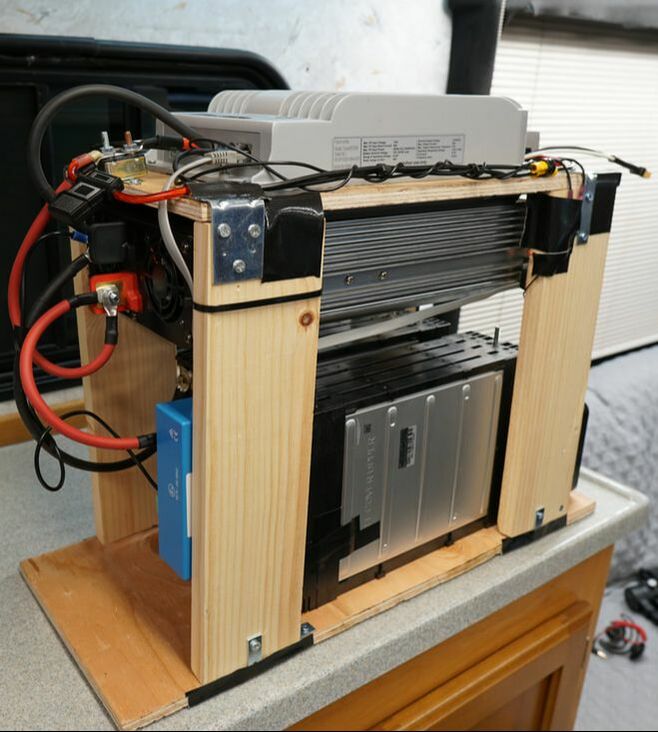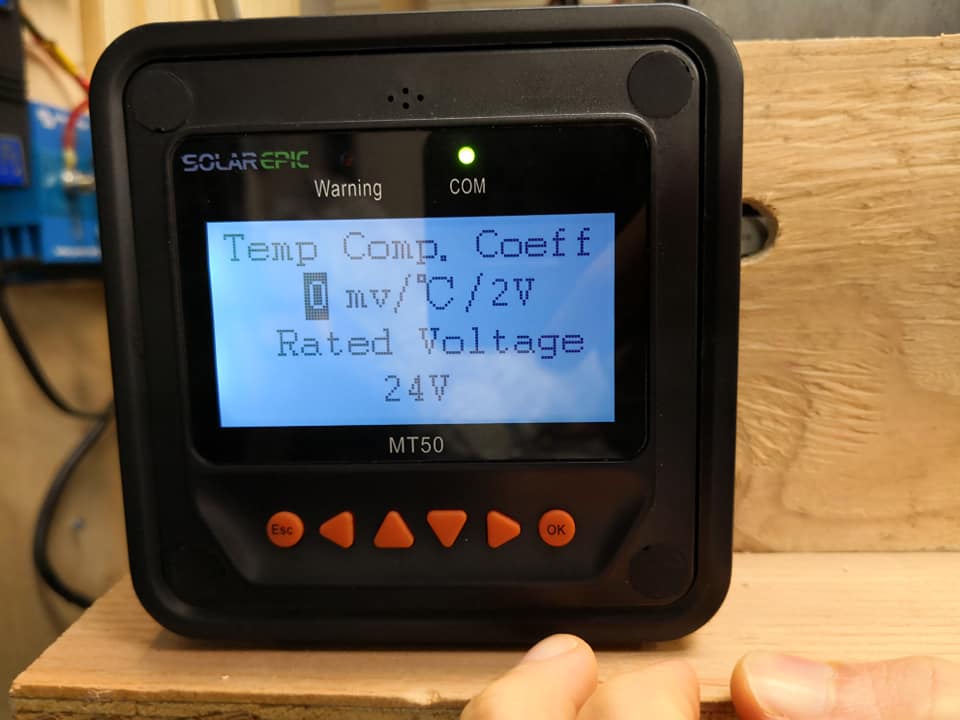DIY Lithium Battery Solar Generator
This project is not for beginners! If you mess up even a single number while programming the charge parameters, you can catch your entire rig on fire! If you understand electronics though, this system is super easy to build, super cheap and insanely powerful!
Lithium Battery Crash Course
There are 5 crucial things that you need if you plan to use a custom built lithium battery:
- Low Temperature Cut-off or Heating System: Lithium batteries can NOT be charged below 0 degrees Celsius. If it is charged below this temperature, it will be permanently damaged and will be unsafe to charge. Try to find a solar charge controller with low temperature cut-off, or build your own thermostat controlled heater pad to keep the battery warm. I am keeping my battery in my living area so it stays nice and warm during the winter.
- MPPT Charge Controller Capable of Charge Profile Editing: Each lithium battery will require a different max charge voltage. To avoid thermal runaway and a fire, you need to program the MPPT charge profile parameters for whatever battery you plan to use.
- Over-Discharge Protection System: If you over discharge a lithium battery, it will change the chemistry of the battery and permanently damage it, and it will be unsafe to charge again. To ensure that this never happens, the battery should be able to disconnect itself from the loads of your system if it is discharged too low. You can build your own relay system, or simply buy a Victron Battery Protect and program the low voltage disconnect for your battery.
- High Temperature Protection: If your system will be in high temperature environment, or discharging at high c ratings that its not designed for, you will need a battery cell cooling system. For solar power systems, lithium batteries rarely need a cooling system. So typically, this is not a big deal at all. But you can add a battery cooling system if you wish.
- Cell Balancing: This may or may not apply to you. If you are charging and discharging from 100% to 0% at high c ratings, your cells will go out of balance over time and you will need to balance them. You can do this manually with a rc battery cell balancer, or you can use a bms. a rc manual balancer is much cheaper, and works well for solar use batteries that rarely go out of balance.
My Dead Simple Solar Lithium Battery Generator:
Updated schematic:
Complete Parts List:
(I Make A Commission For Purchases Made Through The Links Below)
- 2x LG LiPo Battery Module's (ebay sponsored link): Click Here
Ask for a cell balancing cable when you order this battery! They include it for free but you need to ask.
- 2000 watt 24 volt Pure Sine Wave Inverter: Click Here
- Solar Charge Controller with Manual Charge Profile: Click Here
- Victron Battery Protect 220 amp: Click Here
- Programmable battery monitor (manually program max and min voltage settings to estimate capacity): Click Here
- 24 volt to 12 volt Converter (so I can still use 12 volt appliances): Click Here
- 175 amp Bolt on main Fuse (good rating for 24 volt 2000 watt inverter including surge): Click Here
- Cold Temperature Protection Heat Pad: 12 volt thermostatically controlled black water tank heater pad. This will connect to the converter and automatically heat up the battery if the battery gets too cold (I do not have one on mine because I live in san diego). This heat pad will turn on at 45 degrees F, and shut off at 68 degrees F, so to ensure that this heater pad does not waste any power, be sure to insulate the battery compartment and area around the battery. If it is insulated nicely, this pad will work well. If the battery is next to a lot of metal, such as an outdoor battery compartment that is vented, you will need to find another type of heater pad that turns on at a lower temperature. Click Here
- Cell Balancer: If you buy the recommended battery above, it will have a cable that comes out of it that can plug into a cell balancer. The one that I use, and many others use, is this one: Click here
- Amp Meter (put it over the main bolt on fuse to see how much power is going in and out of your system): Click Here
- Recommended Tools: Click Here
- Wood and screws from home depot. Lots of L brackets!
My current Charge Profile Parameters:
Charge limit voltage: 33.1 volts
Charge Voltage Limit: 32 volts
Over voltage reconnect: 33 volts
Equalize: 32 volts
Boost:32 volts
Float: 31.8 volts
Boost reconnect: 24.6
And low voltage cut offs are as low as possible because the battery protect does that job. The load terminals of controller should only be used for voltage monitoring, and not for loads.
Charge Voltage Limit: 32 volts
Over voltage reconnect: 33 volts
Equalize: 32 volts
Boost:32 volts
Float: 31.8 volts
Boost reconnect: 24.6
And low voltage cut offs are as low as possible because the battery protect does that job. The load terminals of controller should only be used for voltage monitoring, and not for loads.
Update: The charge profile parameters above work great, but using a computer to program the controller is horrible. It is so difficult to connect, and it doesn't work everytime. So what you need to do is use the MT-50 to change the parameters manually. It is much easier, but tedious.
Picture guide to change the charge profile parameters on my recommended charge controller:
1. Press "esc" button to reach the main menu. Scroll down and select "4. Control Para." and press "ok". In the control parameter menu, use the arrow keys to navigate around and see the current charge profile parameters.
2. If you want to change a parameter (especially charge limit voltage, if you are using a tesla battery), hold down the "ok" button. If it asks for a password input, leave it blank and hold down "ok". Now you will see the charge profile parameter number flash, and you can use the arrows to change the parameter.
3. When you are done editing the parameter, press "ok" and it will ask you to save the settings. Press "ok" again. You need to repeat this process every time you change parameters on a screen (so you can only edit two parameters at a time).
If you are using the tesla battery, use my current charge profile parameters mentioned early and copy them, one by one, into the controller.
If you are using the tesla battery, use my current charge profile parameters mentioned early and copy them, one by one, into the controller.
if you get the dreaded "para error"..
If you get "para error", it means that one of the figures you are programming does not agree with other parameters. Use the guide below to make sure that your parameters agree with each other. This can be a major pain in the butt. Sometimes you need to program one parameter first, and then another one second to avoid the "para error" message. Here is the guide:
What I like to do to avoid the dreaded "para error" message is I take the default values for a 12v system, and use it as a reference to design a new charge profile at a new voltage (such as the teslas 25.2 volt max system:
Then I will program them in one by one until I get a para error, then I go to the guide mentioned a second ago to figure out which parameter is not agreeing with the others.
It can take a few minutes to get down, but its not that difficult. Its a fun little puzzle and when you solve it, you can do it a hundred times over pretty quickly.
It can take a few minutes to get down, but its not that difficult. Its a fun little puzzle and when you solve it, you can do it a hundred times over pretty quickly.
Final Steps!
3. When you are done editing, use the navigation arrows to ensure that all changes have been saved. Check all numbers! If you mess this up, you can destroy your battery.
4. Connect your system to solar power and watch the charge voltage. If it charges up to the charge limit voltage that you programmed, you are good to go.
4. Connect your system to solar power and watch the charge voltage. If it charges up to the charge limit voltage that you programmed, you are good to go.














